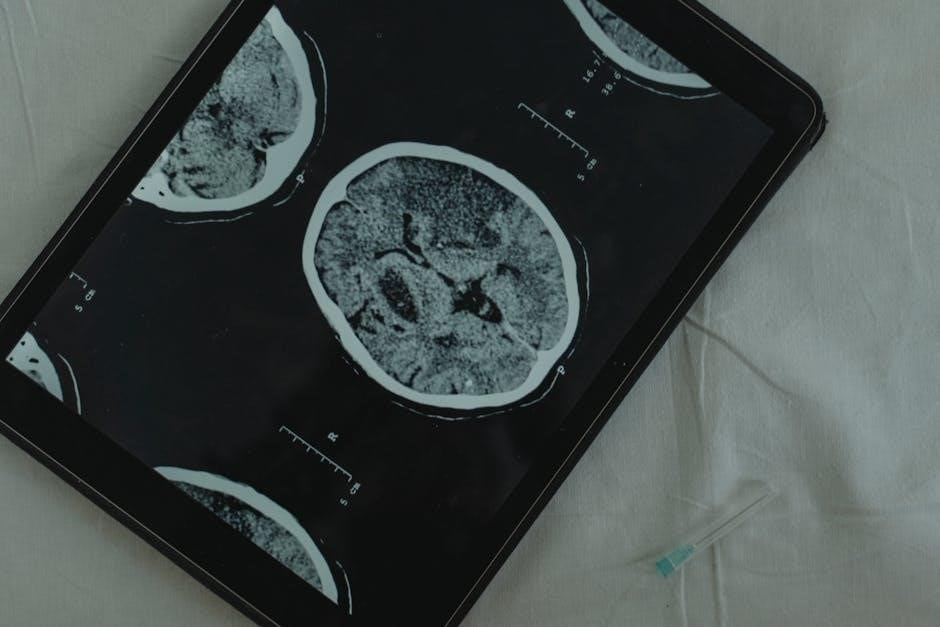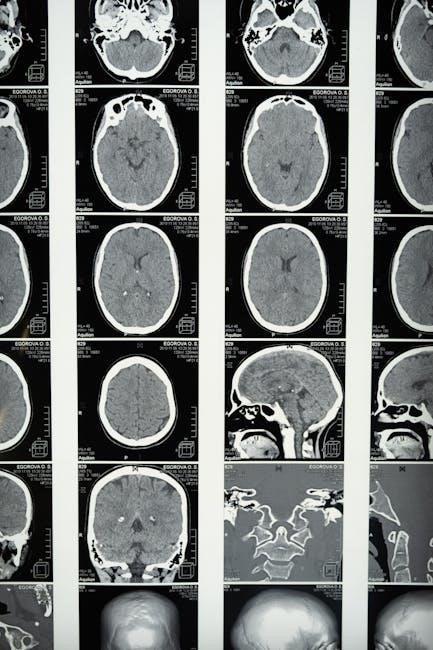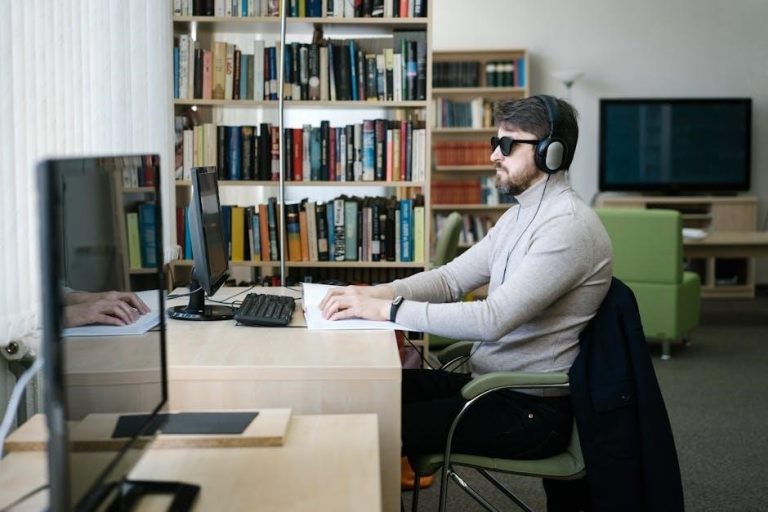Neurology is the medical field studying the brain, spine, and nervous system, focusing on the diagnosis, treatment, and management of neurological disorders to enhance patient outcomes and quality of life.
1.1 Overview of the Brain and Spine
The brain and spine are central to the nervous system, with the brain controlling movement, cognition, and emotions, while the spine houses the spinal cord, which relays messages between the brain and body. These structures are protected by the skull and vertebrae, ensuring their delicate functions remain intact. Damage to either can lead to severe neurological disorders, emphasizing their interconnected importance in overall health. This section provides a foundational understanding of these critical components, essential for grasping neurological health and disease management.
1.2 Importance of Neurological Health
Neurological health is crucial for controlling movement, emotions, and cognitive functions. The brain and spine regulate vital processes, from breathing to complex decision-making. Poor neurological health can lead to debilitating conditions like epilepsy, Parkinson’s, or stroke, significantly impacting quality of life. Prioritizing neurological well-being through lifestyle choices, such as a balanced diet and regular exercise, can prevent or manage these conditions. Early detection and treatment of neurological disorders are essential for maintaining independence and overall health. Protecting the brain and spine ensures optimal functioning, enabling individuals to thrive in their daily lives and maintain emotional and physical stability.

Neurological Disorders of the Brain
Neurological disorders of the brain, such as epilepsy, stroke, and Parkinson’s, significantly impact cognitive and motor functions. Early diagnosis and treatment are crucial for improving patient outcomes.
2.1 Common Brain Disorders (Epilepsy, Stroke, Parkinson’s)
Epilepsy, characterized by recurrent seizures, affects millions worldwide. Strokes occur when blood supply to the brain is interrupted, leading to tissue damage. Parkinson’s disease, marked by tremors and motor dysfunction, progresses gradually. Early detection and targeted therapies improve outcomes. Lifestyle modifications also play a role in managing these conditions.
2.2 Symptoms and Diagnostic Techniques
Common symptoms of brain disorders include headaches, seizures, cognitive decline, and motor dysfunction. Early detection is crucial for effective treatment. Diagnostic techniques like MRI and CT scans provide detailed brain imaging, while EEG measures electrical activity. Lumbar punctures can detect infections or inflammation. Neuropsychological tests assess cognitive function, and blood tests identify underlying causes. Accurate diagnosis guides tailored therapies, improving patient outcomes. These tools are essential for understanding brain health and managing neurological conditions effectively.

Spinal Disorders and Conditions
Spinal disorders encompass a range of conditions, including injuries, infections, and degenerative diseases. Common issues include herniated discs, scoliosis, and spinal stenosis, impacting mobility and overall health. Early diagnosis and treatment are crucial for improving outcomes and maintaining quality of life.
3.1 Understanding Spinal Cord Injuries
Spinal cord injuries (SCIs) involve damage to the spinal cord, disrupting communication between the brain and body. These injuries can be traumatic, such as from accidents, or non-traumatic, resulting from infections or tumors. SCIs are classified as complete or incomplete, depending on the extent of nerve signal loss. Complete injuries result in total loss of motor and sensory function below the injury site, while incomplete injuries preserve some function. Symptoms vary but may include paralysis, loss of reflexes, and sensory deficits. Early medical intervention is critical to prevent further damage and improve recovery outcomes. Rehabilitation and supportive therapies play a significant role in managing SCI.
Degenerative spinal conditions, such as herniated discs and scoliosis, often result from aging or wear and tear. Herniated discs occur when the cushioning between vertebrae ruptures, compressing nearby nerves and causing pain. Scoliosis is a curvature of the spine, which can be congenital or develop later in life. Symptoms include chronic back pain, muscle weakness, and limited mobility. Treatment options range from conservative approaches like physical therapy and pain management to surgical interventions for severe cases. Early diagnosis and tailored treatment plans are essential to alleviate symptoms and prevent further spinal degradation. Regular monitoring and lifestyle adjustments can improve long-term outcomes for patients. Diagnostic tests for brain and spine include imaging techniques like MRI, CT scans, and X-rays, as well as EMG and lumbar punctures to assess neurological conditions. Imaging techniques are crucial for diagnosing brain and spine conditions. MRI provides detailed images of soft tissues, identifying abnormalities like tumors or injuries. CT scans offer quick, high-resolution images, especially useful in emergencies. X-rays are often used to detect fractures or misalignments in the spine. These tools help neurologists visualize structural issues, guiding accurate diagnoses and treatment plans. Each modality has unique advantages, ensuring comprehensive assessment of neurological health. Beyond imaging, neurologists use tools like EMG and lumbar puncture. EMG measures electrical activity in muscles, diagnosing neuromuscular disorders. Lumbar puncture collects cerebrospinal fluid to detect infections or inflammation. These tools provide critical insights, aiding in precise diagnoses and treatment plans for various neurological conditions, ensuring comprehensive patient care and effective management of brain and spine health issues. Neurology treatments include surgical interventions for structural issues and non-surgical approaches like medications and therapy to manage symptoms and improve brain and spine function effectively. Surgical interventions in neurology address complex brain and spine conditions requiring precise techniques. Procedures like craniotomy for tumor removal or aneurysm clipping restore function and relieve symptoms. Spinal surgeries, such as laminectomy or fusion, treat herniated discs or degenerative conditions. Advanced technologies, including minimally invasive methods, reduce recovery times and complications. Neurosurgeons use specialized tools to minimize risks and improve outcomes. These surgeries are often life-changing, offering relief from severe neurological impairments when non-surgical options are ineffective. The goal is to preserve brain and spine function while enhancing patient quality of life. Non-surgical treatments are often the first line of defense in managing neurological conditions. Medications, such as anti-seizure drugs for epilepsy or muscle relaxants for spasticity, alleviate symptoms and slow disease progression. Physical therapy strengthens muscles and improves mobility, while occupational therapy helps patients regain daily living skills. Pain management strategies, including injections or medications, provide relief for chronic conditions. Lifestyle modifications, such as diet changes or stress reduction, complement medical treatments. These approaches aim to enhance quality of life and maintain independence without the risks associated with surgery, offering personalized care tailored to each patient’s needs and condition severity. Preventive measures for neurological health include maintaining a healthy lifestyle, balanced diet, regular exercise, avoiding smoking and alcohol, managing stress, and ensuring mental stimulation and regular check-ups. Adopting a healthy lifestyle is crucial for maintaining brain and spine health. A balanced diet rich in antioxidants, omega-3 fatty acids, and vitamins supports neural function. Regular exercise improves blood flow and reduces inflammation. Avoiding smoking and excessive alcohol consumption prevents neurological damage. Managing stress through mindfulness, yoga, or meditation can protect the brain and spine. Ensuring adequate sleep is essential for cognitive repair and regeneration. Staying mentally active with puzzles, reading, or learning new skills promotes brain resilience. These modifications collectively enhance neurological well-being and reduce the risk of degenerative conditions. Nutrition plays a vital role in brain and spine health. A diet rich in omega-3 fatty acids, found in fish and nuts, supports brain function. Antioxidants like vitamins C and E protect against oxidative stress. B vitamins aid in neurotransmitter production, while magnesium and potassium maintain nerve function. Supplements such as vitamin D and coenzyme Q10 may support neurological health. Proper hydration is essential for maintaining spinal fluid balance. A well-balanced diet, combined with appropriate supplements, can prevent deficiencies and promote long-term neurological well-being, reducing the risk of conditions like dementia and neuropathy. Recent advancements in neurology include stem cell therapies, gene therapy, and immunotherapy for neurodegenerative diseases. Improved imaging techniques and minimally invasive surgical methods have enhanced diagnostic and treatment precision. Stem cell research has emerged as a groundbreaking area in neurology, offering potential treatments for conditions like Parkinson’s, spinal cord injuries, and multiple sclerosis. By harnessing the ability of stem cells to differentiate into various neural cells, scientists aim to repair or replace damaged neural tissues. Regenerative medicine approaches, including gene therapy and cell transplantation, are being explored to restore lost function and promote healing in the brain and spinal cord. These advancements hold promise for revolutionizing the treatment of previously incurable neurological disorders. Minimally invasive surgical techniques are revolutionizing neurology, offering precise and less damaging approaches to brain and spine surgeries. Procedures like endoscopic surgery and laparoscopic-assisted methods reduce recovery times and minimize complications. Robotic-assisted surgeries enhance accuracy, enabling intricate operations with smaller incisions. These techniques are particularly effective for spinal decompression, herniated disc repairs, and certain brain tumor removals. By reducing tissue trauma and scarring, minimally invasive methods improve patient outcomes, leading to faster recovery and fewer post-operative risks. Such advancements underscore the evolving nature of neurological care, prioritizing patient well-being and surgical efficiency. The future of neurology promises transformative advancements, with emerging technologies like AI, gene therapy, and personalized medicine revolutionizing diagnostics and treatments, enhancing patient care and outcomes significantly. Emerging technologies in neurology are reshaping patient care through innovative approaches like stem cell therapy, gene editing, and brain-computer interfaces. These advancements hold promise for treating previously incurable conditions such as Parkinson’s disease and spinal injuries. Additionally, artificial intelligence is being integrated into diagnostic tools, enabling earlier and more accurate detection of neurological disorders. Minimally invasive surgeries and robotics are also improving surgical precision, reducing recovery times, and enhancing outcomes. Together, these technologies are paving the way for a new era of personalized and regenerative neurologic care. Future breakthroughs in brain and spine care may include advancements in neural interface technology, enabling better communication between the brain and external devices. Regenerative medicine could lead to spinal cord repair, restoring mobility in paralyzed individuals. Gene therapy shows promise in treating genetic neurological disorders, while immunotherapy may target conditions like multiple sclerosis. Additionally, artificial intelligence could revolutionize diagnostics, predicting conditions before symptoms arise. These innovations, combined with personalized medicine, aim to transform care, offering hope for previously untreatable conditions and improving quality of life for millions.3.2 Degenerative Conditions (Herniated Discs, Scoliosis)

Diagnostic Tests for Brain and Spine
4.1 Imaging Techniques (MRI, CT Scan, X-rays)
4.2 Other Diagnostic Tools (EMG, Lumbar Puncture)

Treatment Options in Neurology
5.1 Surgical Interventions (Brain and Spine Surgery)
5.2 Non-Surgical Approaches (Medications, Therapy)

Preventive Measures for Neurological Health

6.1 Lifestyle Modifications for Brain and Spine Health
6.2 Role of Nutrition and Supplements

Recent Advancements in Neurology
7.1 Stem Cell Research and Regenerative Medicine

7.2 Advances in Surgical Techniques (Minimally Invasive)

The Future of Neurology
8.1 Emerging Technologies and Treatments
8.2 Potential Breakthroughs in Brain and Spine Care
